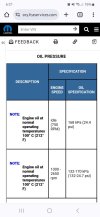My new truck has 400 miles on it now and noticed going through the gages that the oil pressure seems so low it's between.
20-30 psi but typical is 22-24 psi just driving normal.
When put foot in it lightly for better acceleration I have seen 32psi.
I have no idea about the volume on these pumps I know how important it is from the old V8 and the cam/lifter issues.
I know 0-20 weight oil is in these
 3.0 SO models and on the HO motor they use the 0-40 weight.
3.0 SO models and on the HO motor they use the 0-40 weight.
on the 1st oil change I will be going with the 0-40 as long as ram care says it will not void the warranty.
20 weight oil is just no good enough in my opinion for the stress and especially the heat created from engine and turbos really need the protection.
I swear these company's want your engines to fail by doing things like this.
Last truck was a 6.7 Cummins always around 40+ to 52 PSI and hits the bypass.
the V8's I think is like 70PSI on bypass.
these aren't Harleys running at 8psi oil pressure, they're TWIN TURBO 10.5 : 1 compression engines that's a lot of load and pressure on bearings.
come on RAM! it better hold up for no less than 100k miles.
it better hold up for no less than 100k miles.
Thank you for your comments I look forward to hearing others information on these new engines and the truck in general.
20-30 psi but typical is 22-24 psi just driving normal.
When put foot in it lightly for better acceleration I have seen 32psi.
I have no idea about the volume on these pumps I know how important it is from the old V8 and the cam/lifter issues.
I know 0-20 weight oil is in these
on the 1st oil change I will be going with the 0-40 as long as ram care says it will not void the warranty.
20 weight oil is just no good enough in my opinion for the stress and especially the heat created from engine and turbos really need the protection.
I swear these company's want your engines to fail by doing things like this.
Last truck was a 6.7 Cummins always around 40+ to 52 PSI and hits the bypass.
the V8's I think is like 70PSI on bypass.
these aren't Harleys running at 8psi oil pressure, they're TWIN TURBO 10.5 : 1 compression engines that's a lot of load and pressure on bearings.
come on RAM!
Thank you for your comments I look forward to hearing others information on these new engines and the truck in general.













